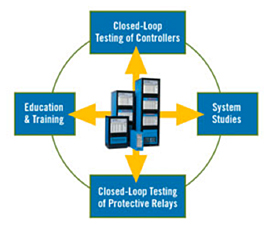Applications
Applications
 The RTDS Simulator is a fully digital electromagnetic transient power system simulator used to conduct closed-loop testing of physical devices, such as protection equipment and control equipment including IEC 61850 devices, to perform analytical system studies, and to educate operators, engineers and students.
The RTDS Simulator is a fully digital electromagnetic transient power system simulator used to conduct closed-loop testing of physical devices, such as protection equipment and control equipment including IEC 61850 devices, to perform analytical system studies, and to educate operators, engineers and students.
It is a cost-effective replacement for transient network analyzers and analogue/hybrid simulators.
The simulator is a combination of advanced computer hardware and comprehensive software. Power system networks are created on the computer screen by arranging electrical components from any number of customized component model libraries. RSCAD is the main interface with the RTDS Simulator hardware and is designed to allow the user to perform all the steps necessary to prepare and run the simulation, and to analyze its output. Our hardware is fully modular, allowing a user to expand to accommodate even the most complex and detailed system models.
Of paramount importance is the fact that the RTDS Simulator works in continuous, sustained real time. That is, it can solve the power system equations fast enough to continuously produce output conditions that realistically represent conditions in the real network. Because the solution is real time, the simulator can be connected directly to power system control and protective relay equipment.
The RTDS Simulator is currently applied to many areas of development, testing, and studying of the following:
- protective relaying schemes
- integrated protection and control systems
- control system for HVDC, SVC, synchronous machines, and FACTS devices
- general AC and DC system operations and behaviour
- interaction of AC and DC systems
- interaction of various electrical installations (e.g. between two HVDC systems)
- demonstration and training
Many of these experiences have been documented and published. Please contact us for more information.
 Espaņol
Espaņol
